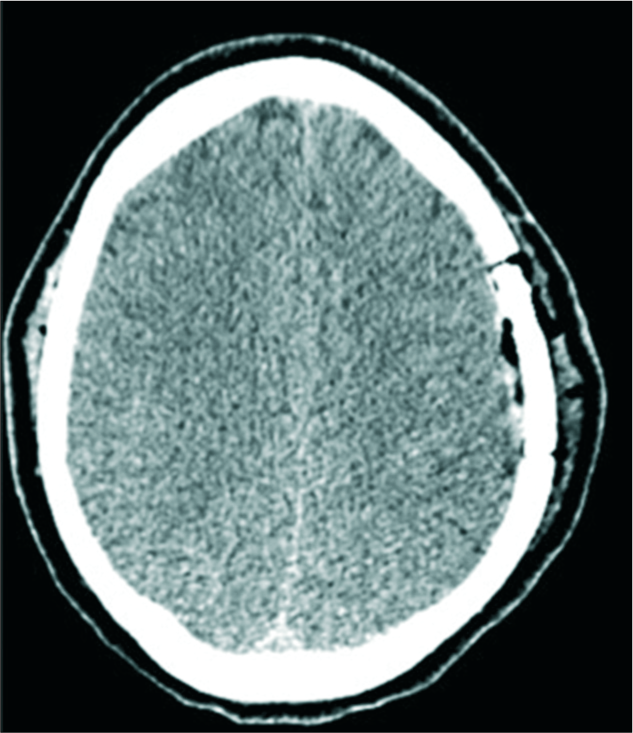- Department of Neurosurgery, Hospital das Clinicas da Faculdade de Medicina da USP, Sao Paulo, Brazil,
- Neurosurgery Service, Clinica Girassol, Luanda, Angola.
Correspondence Address:
Adilson de Oliveira
Department of Neurosurgery, Hospital das Clinicas da Faculdade de Medicina da USP, Sao Paulo, Brazil,
DOI:10.25259/SNI_499_2019
Copyright: © 2020 Surgical Neurology International This is an open-access article distributed under the terms of the Creative Commons Attribution-Non Commercial-Share Alike 4.0 License, which allows others to remix, tweak, and build upon the work non-commercially, as long as the author is credited and the new creations are licensed under the identical terms.How to cite this article: Adilson de Oliveira, Wellingson da Silva Paiva, Manoel Jacobsen Teixeira. Rare acute idiopathic subdural hematoma: A case report and literature review. 17-Jan-2020;11:9
How to cite this URL: Adilson de Oliveira, Wellingson da Silva Paiva, Manoel Jacobsen Teixeira. Rare acute idiopathic subdural hematoma: A case report and literature review. 17-Jan-2020;11:9. Available from: https://surgicalneurologyint.com/surgicalint-articles/9849/
Abstract
Background: Acute spontaneous subdural hematoma is rare. For patients under 40 years of age, we found only five previous reports. Here, we have presented a sixth case study.
Case Description: A 27-year-old male initially presented with a high-intensity headache without any neurological deficits. The brain computed tomography revealed a left frontoparietal lesion, consistent with an acute epidural hematoma. However, the bone window examination showed no fracture, and at surgery, this lesion proved to be an acute subdural hematoma. Additional studies, including cerebral angiography, brain magnetic resonance imaging, and a complete coagulation work-up, were all negative.
Conclusion: This case report and literature review focused on the rarity of acute idiopathic/spontaneous subdural hematomas.
Keywords: Intracranial hematoma, Neurosurgery, Subdural hematoma, Traumatic brain injury
INTRODUCTION
There are few documented cases of acute spontaneous subdural hematomas (ASSDH) occurring in healthy young men without a history of trauma [
CASE REPORT
A 27-year-old male presented with a high-intensity headache of 3 h duration. He exhibited no focal neurological deficit or any laboratory/coagulation abnormalities [
DISCUSSION
History of ASSDH
Munro, in 1934, was the first to report an ASSDH; a decade later, Scott reported two more cases.[
Risk factors for ASSDH
Risk factors for ASSDH included hypertension, vascular malformations, neoplasia (e.g., hematological malignancies causing thrombocytopenia), other solid tumors, dural metastases, hypervitaminosis, coagulopathy/alcoholism, and bleeding from cerebral artery aneurysms/cortical arteries. In the case presented, the patient had none of these risk factors. Notable, however, was the CT finding of a lenticular clot pathognomonic for an epidural hematoma (e.g., only 8% of subdural hematomas demonstrate this radiological shape), but without a fracture on the bone window CT.[
CONCLUSION
Spontaneous intracranial hematomas are rare life-threatening lesions that typically present with mild symptoms and less severe neurological findings versus traumatic acute subdural hematomas. In addition to obtaining preoperative noncontrast CT bone and soft-tissue studies, patients postoperatively should undergo brain MR scans, cerebral angiography, and a full coagulation work-up to rule out other etiologies of these rare lesions.
Declaration of patient consent
The authors certify that they have obtained all appropriate patient consent forms.
Financial support and sponsorship
Nil.
Conflicts of interest
There are no conflicts of interest.
References
1. Arnold PM, Christiano LD, Klemp JA, Anderson KK. Nontraumatic spontaneous acute subdural hematoma in identical teenage twins 1 year apart. Pediatr Emerg Care. 2011. 27: 649-51
2. Avis SP. Nontraumatic acute subdural hematoma. A case report and review of the literature. Am J Forensic Med Pathol. 1993. 14: 130-4
3. Brennan PM, Fuller E, Shanmuganathan M, Keston P, Fouyas I. Spontaneous subdural haematoma in a healthy young male. BMJ Case Rep. 2011. 2011: bcr0120113694-
4. Coombs JB, Coombs BL, Chin EJ. Acute spontaneous subdural hematoma in middle aged adult: Case report and literature review. J Emerg Med. 2014. 212: 1-6
5. Depreitere B, Van Calenbergh F, van Loon J. A clinical comparison of non-traumatic acute subdural haematomas either related to coagulopathy or of arterial origin without coagulopathy. Acta Neurochir (Wien). 2003. 145: 541-6
6. Kulah A, Taşdemir N, Fiskeci C. Acute spontaneous subdural hematoma in a teenager. Childs Nerv Syst. 1992. 8: 343-6
7. Marconi F, Fiori L, Parenti G, Ravelli V. Acute spontaneous subdural haematoma. Description of four clinical cases. J Neurosurg Sci. 1991. 35: 97-102
8. Missori P, Fenga L, Maraglino C, Rocchi G, Nardacci B, Calderaro G. Spontaneous acute subdural hematomas. A clinical comparison with traumatic acute subdural hematomas. Acta Neurochir (Wien). 2000. 142: 697-701
9. Monsivais D, Choi HA, Kitagawa R, Franch M, Cai C. A retrospective analysis of surgical outcomes for acute subdural hematoma in an elderly cohort. Interdiscip Neurosurg. 2018. 14: 130-4
10. Munro D. The diagnosis and treatment of subdural hematoma. A report of sixty two cases. N Engl J Med. 1934. 210: 1145-60
11. Scott M. Spontaneous nontraumatic subdural hematomas. J Am Med Assoc. 1949. 141: 596-602
12. Su IC, Wang KC, Huang SH, Li CH, Kuo LT, Lee JE. Differential CT features of acute lentiform subdural hematoma and epidural hematoma. Clin Neurol Neurosurg. 2010. 112: 552-6
13. Talalla A, McKissock W Acute. “spontaneous” subdural hemorrhage. An unusual form of cerebrovascular accident. Neurology. 1971. 21: 19-25












